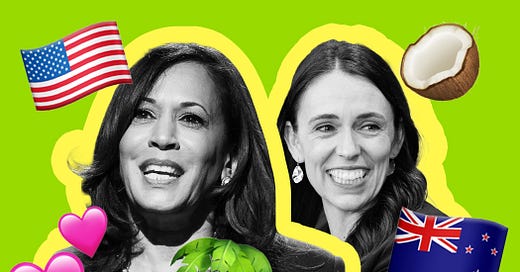
Brace Yourself for Harrismania
Check out the story of the ‘Jacindamania’ that followed generational turnover in New Zealand’s political leadership.
HERE IS A POLITICAL FABLE: A party leader, an elder statesman from a center-left party, has lost his mandate. He’s up against a beatable opponent from the right, but he’s unpopular. It’s less than two months until Election Day, and the polls say he can’t win. So he steps down and anoints his deputy, a young woman, the new party leader. There’s an instant change. Overnight, donations start to roll in, volunteers sign up. Poll numbers rocket. The new leader scores well, especially among young voters and women. The press is infatuated. When the votes are counted, the young leader has defied the odds. She’s put together a big enough coalition to beat the conservative party.
This is the story of Jacindamania in New Zealand—and it could presage what we’re about to see unfold in the United States.
The young leader is Jacinda Ardern. Her former boss is Andrew Little. As a leader, Little was unloved: a party creature beholden to unions. His political opponents nicknamed him “Angry Andy.” The Labour Party, which Little led, had endured nine years of defeat and disorganization. They couldn’t shake the sense they had nothing coherent to offer. Instead of making his short-term job security the cause for the Labour Party’s defeat, Little, in a remarkable show of humility, let it go. He unleashed Ardern.
Prior to her ascent, Ardern, a 37-year-old career politician, had been seen as upwardly mobile, but there was no indication of the star power to come. She had decent name recognition and limited governing experience. It’s hard to explain what changed. Once Ardern had the top spot, the public went mad for the possibility of a Xennial woman as prime minister. By New Zealand standards, Ardern was a fundraising beast and a genuine public draw. She had a certain school-valedictorian chic—the belle of the model UN—and she embraced social media, communicating with Facebook Live, for instance, and looking natural in selfies.
“The Jacinda effect is the explosion of interest and positive support for the Labour Party based on the personality of Jacinda Ardern, I’ve never seen anything like it,” said political commentator Bryce Edwards at the time. To be sure, Labour had cultivated positive press for Ardern, but the level of enthusiasm was a shock to everyone. Ardern’s name became uttered alongside generational political stars: Trudeau, Blair, and Obama. Her opponents didn’t know how to respond. They barely had time to.
When the election arrived, Ardern had reversed Labour’s flagging fortunes, putting the party in contention for leadership in the post-election negotiations. She won over a populist center-right party and an environmentalist party to her coalition, crowding out the major incumbent party.
The center-right party Ardern defeated had been extremely popular. Even so, at nine years in, it had reached the natural limit of most New Zealand governments. New Zealanders love to “give the other lot a go,” so there was some good timing in Ardern’s arrival. Yet Andrew Little hadn’t been able to capitalize on the popular fatigue with the incumbents. Even though Arden had almost entirely made her bones in left-wing party circles (in New Zealand and the U.K.), she seemed new. She was young. She was hip. She was serious. She had an uncommon political talent that only flowered in her roles as party leader and later prime minister.
WE TELL FABLES TO TEACH. Though Jacindamania is a sample size of one and New Zealand is a comparatively tiny democracy, we might take some lessons from this story.
First, narratives can change extremely quickly. The public and the media in particular were swept up in Ardern’s momentum. It is difficult to convey how much Jacinda’s charisma changed the energy of the election. The Labour Party’s demeanor and fortunes changed overnight. The lateness of the decision provided an assist: The six-week campaign played to Ardern’s strengths, while her and her party’s limitations were unexposed.
Lesson: Democrats should be aware that surprising, new candidates can be narrative dynamite. They attract the press, of course, but you can never quite guess how the public will respond to new realities.
Second, the appointment to leadership usually dramatically raises the credibility of those in the role. Ardern hardly figured in polls for prime minister until she became Labour Party leader. As soon as she was elevated to the party leadership, she rivaled the incumbent in popularity. People want to support someone with a realistic chance of winning.
Likewise, Ardern’s name-ID very quickly went through the roof. The much longer presidential campaigns in the United States have distorted assumptions about how much time it takes for a candidate to register with voters. Kamala Harris is relatively new to national office, especially compared to the man she’s replacing, but now she will gain massive plausibility and name recognition. She has a unique chance to define herself for the first time to most voters from the position of a credible presidential candidacy.
Third, youth or relative youth has real upside in a political contest characterized by staid leaders and institutions. This is almost certainly true in the United States, where the upper echelons of national leadership have for so long been dominated by the Baby Boom generation—now the boomer gerontocracy.1 The people rendered a verdict on Biden’s age. Generational transition alone is a potent argument.
Finally, there is honor in passing the mantle of leadership at the right time. George Washington, Pope Benedict, and Andrew Little all rightly sensed when to let go, and we celebrate them for it. For his part, Little held ministerial positions in Ardern’s government and distinguished himself in them.
OF COURSE, THERE ARE CAVEATS to this story. New Zealand, again, is small; it has the population of South Carolina and its own distinct political system and culture. It’s not as negatively polarized as the United States. But in its smallness and relative isolation, it is an insulated laboratory of democracy.
And to be sure there are plenty of counterexamples—usually when a leader is brought in to put a new face on a creaking government in order to eke out another term, it doesn’t end well. But that is not what is happening here. The Democrats, under Biden, only governed for a single term, and his unpopularity was linked specifically to his age. Meanwhile, Trump suffers his own incumbency fatigue, having dominated the political scene for eight years and explicitly threatened a return to chaotic politics and headlines. In other words, it may be the right moment for a new, narrative-upending candidate.
Every political career ends in failure in one way or another. In office, Ardern proved to be an excellent crisis leader. Her empathy and decisiveness led New Zealand through a terrorist attack, natural disaster, and most notably—and to much international acclaim—the COVID pandemic. Nevertheless, her campaign promises about policy and style of government proved impossible to implement.
Hampered by crises, Ardern inevitably failed to resolve some of New Zealand’s structural problems, but some of her challenges were self-inflicted. She led cautiously, even between 2020 and 2023 when her party had free rein without coalition partners. The bench of effective ministers at her disposal remained relatively shallow. Perhaps this was due to Ardern’s failure to spot talent or trust those outside a narrow circle. Maybe Labour just wasn’t quite ready for victory in 2017.
In any case, burned out and reading the polls, Ardern herself in early 2023 stepped aside for Chris Hipkins, a competent and combative minister. The trick didn’t work a second time. After an initial bump, the weight of incumbency, high inflation, and a delayed backlash against Ardern’s approach to COVID dragged down Hipkins. Meanwhile, the center-right put forward their own blank slate candidate, another relative novice with plenty of upside. Labour was eviscerated. New Zealanders do love to give the other lot a go.
Joe Biden was born in 1942, so he—like Mitch McConnell (born 1942) and Nancy Pelosi (born 1940)—is technically a pre-boomer. Bill Clinton, George W. Bush, and Donald Trump were all born within a few weeks of one another in 1946. Barack Obama was born in 1961; Kamala Harris in 1964.

















